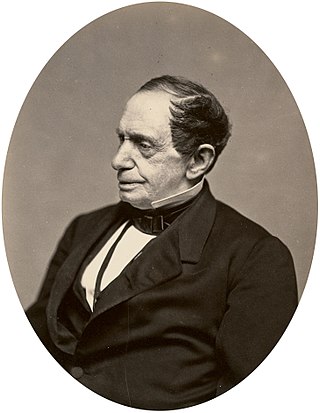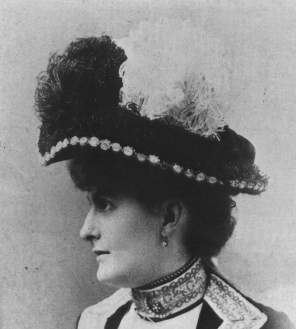
Springfield is the capital of the U.S. state of Illinois and the county seat of and most populous city in Sangamon County. The city's population was 114,394 at the 2020 census, which makes it the state's seventh most-populous city, the second largest outside of the Chicago metropolitan area, and the largest in central Illinois. Approximately 208,000 residents live in the Springfield metropolitan area.

Johns Hopkins was an American merchant, investor, and philanthropist. Born on a plantation, he left his home to start a career at the age of 17, and settled in Baltimore, Maryland, where he remained for most of his life.

An orphanage is a residential institution, total institution or group home, devoted to the care of orphans and children who, for various reasons, cannot be cared for by their biological families. The parents may be deceased, absent, or abusive. There may be substance abuse or mental illness in the biological home, or the parent may simply be unwilling to care for the child. The legal responsibility for the support of abandoned children differs from country to country, and within countries. Government-run orphanages have been phased out in most developed countries during the latter half of the 20th century but continue to operate in many other regions internationally. It is now generally accepted that orphanages are detrimental to the emotional wellbeing of children, and government support goes instead towards supporting the family unit.

Lincoln Home National Historic Site preserves the Springfield, Illinois home and related historic district where Abraham Lincoln lived from 1844 to 1861, before becoming the 16th president of the United States. The presidential memorial includes the four blocks surrounding the home and a visitor center.

Robert Russa Moton was an American educator and author. He served as an administrator at Hampton Institute. In 1915 he was named principal of Tuskegee Institute, after the death of founder Booker T. Washington, a position he held for 20 years until retirement in 1935.
Mordecai Lincoln was an uncle of U.S. President Abraham Lincoln. He was the eldest son of Captain Abraham Lincoln, a brother of Thomas Lincoln and Mary Lincoln Crume, and the husband of Mary Mudd. Lincoln is buried at the Old Catholic or Lincoln Cemetery near Fountain Green, Illinois.
The Illinois Historic Preservation Division, formerly Illinois Historic Preservation Agency, is a governmental agency of the U.S. state of Illinois, and is a division of the Illinois Department of Natural Resources. It is tasked with the duty of maintaining State-owned historic sites, and maximizing their educational and recreational value to visitors or on-line users. In addition, it manages the process for applications within the state for additions to the National Register of Historic Places.

The Dana–Thomas House is a home in Prairie School style designed by architect Frank Lloyd Wright. Built from 1902–1904 for patron Susan Lawrence Dana, it is located along East Lawrence Avenue in Springfield, Illinois. The home reflects the mutual affection of the patron and the architect for organic architecture, the relatively flat landscape of the U.S. state of Illinois, and the Japanese aesthetic as expressed in Japanese prints.

The Minnesota State Public School for Dependent and Neglected Children was a residential and educational facility for wards of the state from 1886 to 1945, located in Owatonna, Minnesota, United States. The State School was created by an act of the Minnesota legislature in 1885 as an effort to provide safe, transitional housing for the state's orphaned, abandoned, and abused children. The goal was to remove at-risk children from harmful situations and place them in the State School, where they would reside in a home-like setting, receive an education, and eventually be placed with suitable farm families. Over 60 years of operation, the State School was home to a total of 10,635 children.

The Hebrew Orphan Asylum of New York (HOA) was a Jewish orphanage in New York City. It was founded in 1860 by the Hebrew Benevolent Society. It closed in 1941, after pedagogical research concluded that children thrive better in foster care or small group homes, rather than in large institutions. The successor organization is the JCCA, formerly called the Jewish Child Care Association.

Lincoln Depot is located in Springfield, Illinois. It is so called because Abraham Lincoln's bittersweet 1861 Farewell Address to Springfield was delivered here as he boarded the train to Washington D.C. at the beginning of his presidency.

The Protestant Children's Home, also known as the Protestant Orphans' Asylum, is a historic orphanage building in Mobile, Alabama, United States. It was placed on the National Register of Historic Places on June 18, 1973.
In 2015 the building was leased to the Infant Mystics society which began using it as a meeting lodge, renaming the place Cotton Hall.

The Iowa Soldiers' Orphans' Home, also known at the Annie Wittenmyer Home or the Annie Wittenmyer Center, located in Davenport, Iowa, United States is a former orphanage for children. It is listed on the Davenport Register of Historic Properties and as a historic district on the National Register of Historic Places. The home was originally used for orphans from the American Civil War. Starting in 1876, children from broken homes, as well as orphans from all of Iowa's 99 counties, were taken in at the home.

Wartburg Mount Vernon Inc. is a non-profit, Lutheran organization located in Mount Vernon, New York that provides a continuum of care to older adults through residential and community-based programs and services. Wartburg was founded in 1866 as an orphanage and farm school and began serving older adults in 1898. As the foster care system took hold in the mid-1900s, Wartburg gradually phased out the orphanage and by 1979, its focus was solely on serving the elderly.

West Virginia Colored Children's Home, also known as the West Virginia Colored Orphans Home, the West Virginia Home for Aged and Infirm Colored Men and Women, and University Heights Apartments, was a historic school, orphanage, and sanatorium building located near Huntington, Cabell County, West Virginia. It was the state's first social institution exclusively serving the needs of African American residents. The main structure, built in 1922–1923, was a three-story red brick building in the Classical Revival style. That building, located at 3353 U.S. Route 60, Huntington, West Virginia, was the last of a series of buildings that were constructed on the site. It was listed on the National Register of Historic Places in 1997.
The Springfield and Central Illinois African-American History Museum is a museum of African-American history and culture located in Springfield in the U.S. state of Illinois. The museum was founded in 2012 by historical educator Douglas King, and moved to a permanent location adjacent to Springfield's Oak Ridge Cemetery in March 2016. The history museum is located in the former home of the Museum of Funeral Customs, which closed permanently in 2009.
E. Belle Mitchell Jackson was an American educator, activist, small business owner, and abolitionist from Danville, Kentucky. Mitchell was one of the founders of the Colored Orphans Industrial Home in Lexington, Kentucky.

Susan Lawrence Dana was an American philanthropist and heiress to a substantial fortune, including silver mines in the Rocky Mountains. After her father died, Lawrence Dana took over his western mines and properties throughout central Illinois. She was also a leading philanthropic figure in Illinois - she held fundraisers or parties for Springfield charities, including the King’s Daughters Home for Aged Women, the Home for the Friendless and several others. She also commissioned Frank Lloyd Wright to create a library for the Lawrence Education Center, named after her father.

The Howard Colored Orphan Asylum was one of the few orphanages to be led by and for African Americans. It was located on Troy Avenue and Dean Street in Weeksville, a historically black settlement in what is now Crown Heights, Brooklyn, New York City. The asylum gradually deteriorated due to lack of funding, and closed in 1918 after an incident involving burst water pipes, which resulted in two students contracting frostbite and having their feet amputated.

The National Home for Destitute Colored Women and Children, later known as the Merriweather Home for Children, was a relief association in the Pleasant Plains neighborhood of Washington, D.C.


















